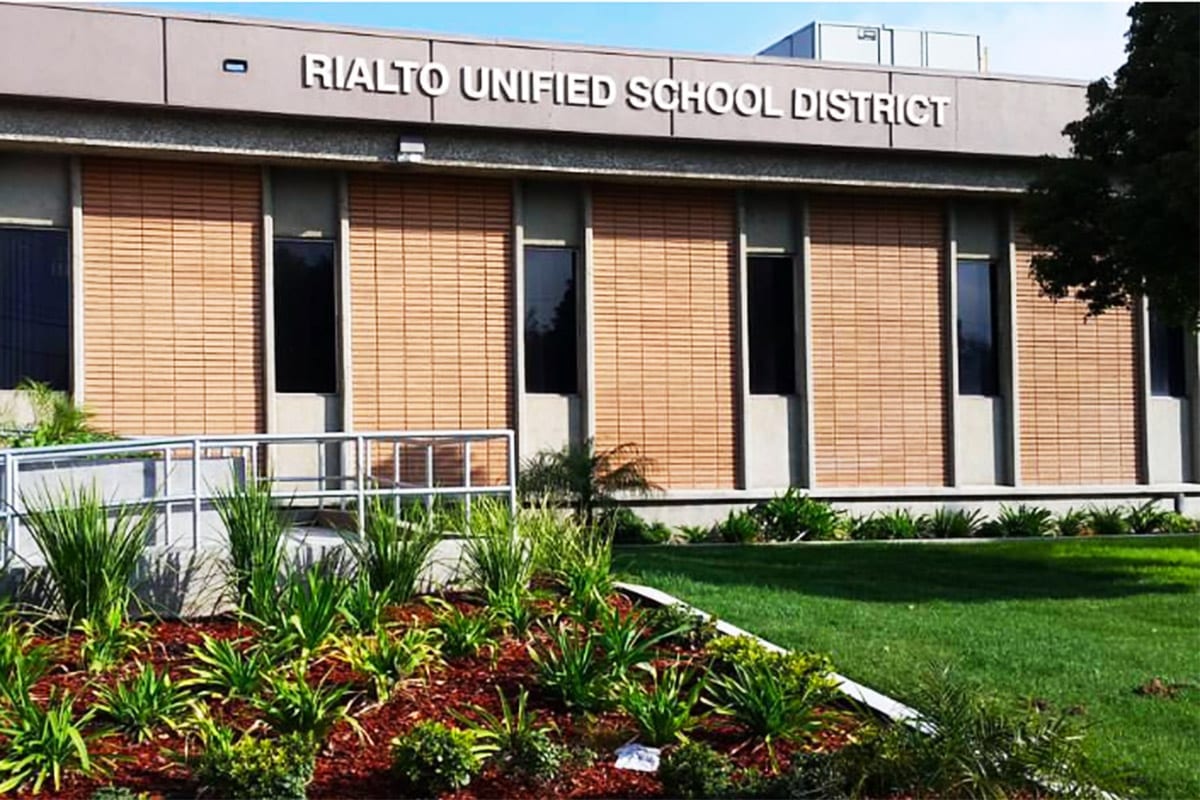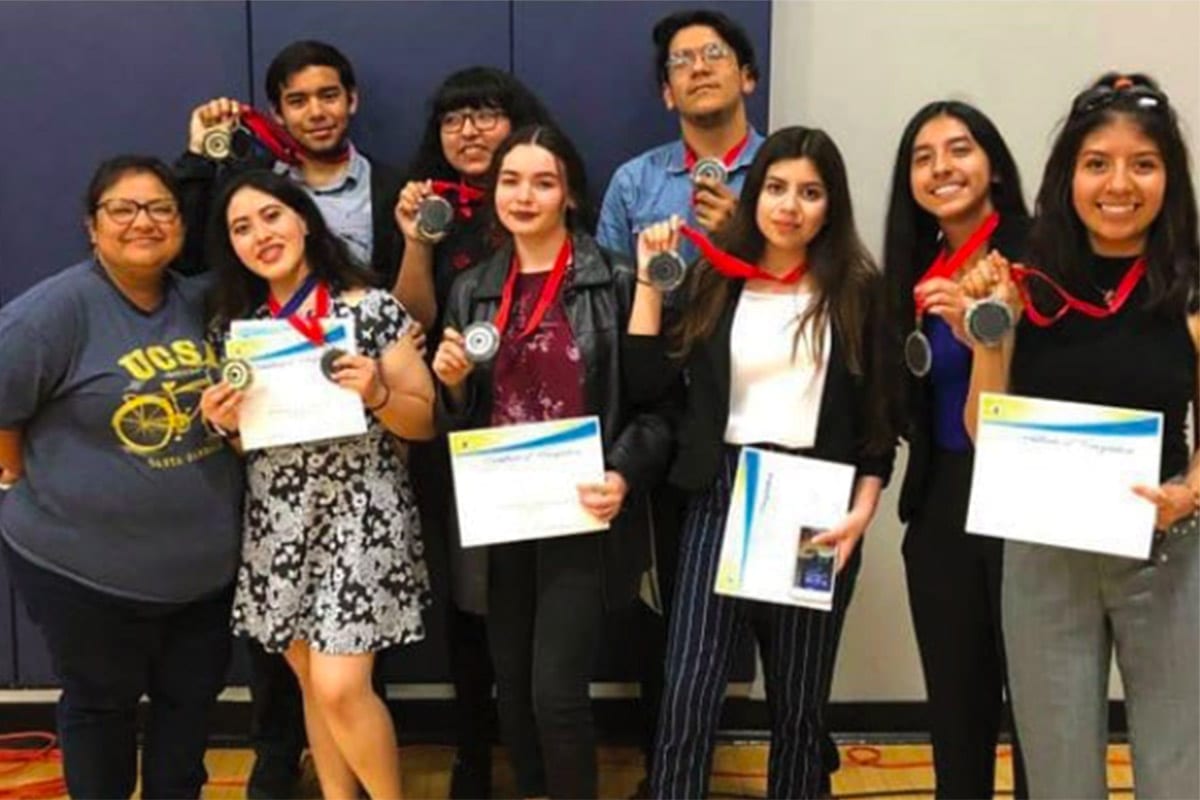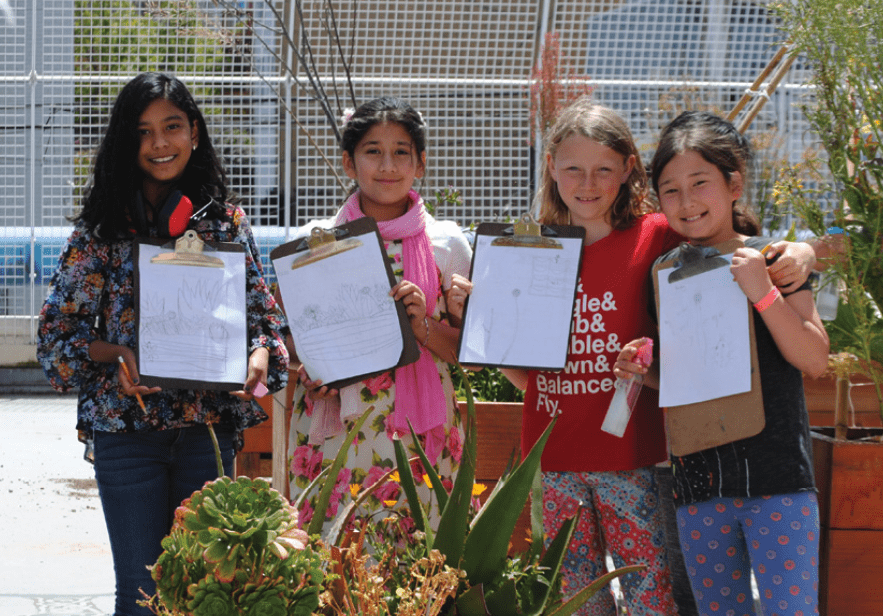This Is Environmental Literacy: Rialto
The Wigwam Motel is a horseshoe-shaped collection of 19 stucco structures fashioned after teepees located on a stretch of historic Route 66 in Rialto, California. The final installment of designer Frank Redford’s Wigwam Villages (there were seven, three remain), built in 1949, was purchased and lovingly restored in 2003 by a family who emigrated from India and became U.S. citizens. They continue to own and maintain the Wigwam, added to the National Register of Historical Places in 2012, to this day.
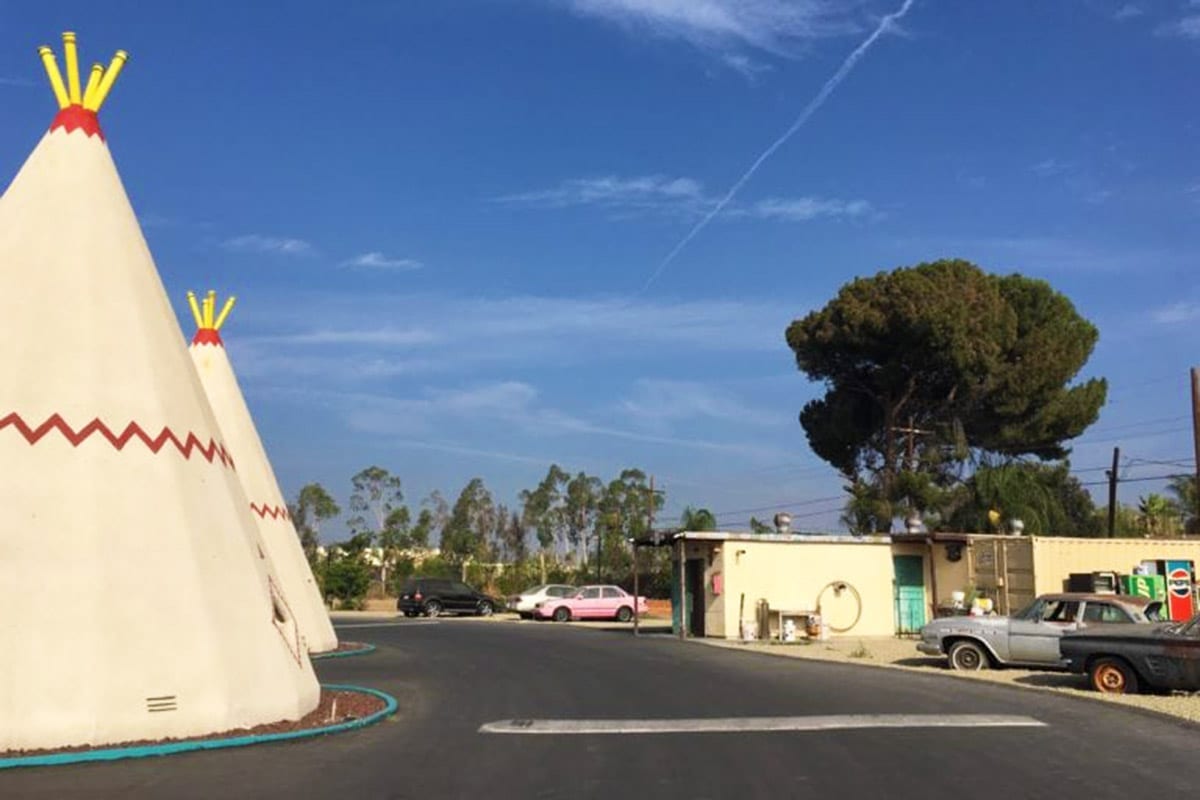
When I meet Juanita Chan, Coordinator for STEM, Related College and Career Pathways, and Adult Ed at the Rialto Unified School District the next morning I mention how well I slept in the concrete teepee. Her enthusiastic response sets the tone for the next 48 hours of my stay in the Inland Empire:
“Oh my gosh you’re staying at the Wigwam?! I’ve always wanted to go in one of them—what are they like inside?”
I get the distinct feeling that beyond a good night’s rest, I’ve inadvertently acquired some measure of credibility from a gifted and passionate educator whom I’ve quietly admired and respected for the last year and a half.
Rialto USD comprises 19 Elementary Schools, 5 Middle Schools, 3 Comprehensive High Schools, 1 Alternative High School, and 1 Independent Student High School serving over 27,000 Inland Empire students—85.5% of whom are counted as unduplicated pupils. (CDE defines an unduplicated pupil as any student to whom one or more of the definitions included in Education Code section 42238.01 apply, including students eligible for free or reduced price meals, foster youth, and English learners.)
The history of this place, and the story of what Ms. Chan and the district are doing to provide effective student-centered learning are inexorably intertwined, and illustrate another instance of how district-level support, committed educators, and community partnerships—working in concert with a place itself—enhance student engagement and support student success. Environmental literacy is woven throughout their innovative strategy to serve their students.
Laying the Groundwork for Environmental Literacy
Rialto differs from the other districts in the This Is Environmental Literacy series in that they are one of a handful of Leading-edge Exemplar districts supported by the California Environmental Literacy Initiative. However, Rialto USD began laying the groundwork in 2003—well before Superintendent Torlakson’s Environmental Literacy Task Force convened in 2014 to produce California’s Blueprint for Environmental Literacy.
At that time Dr. Edward D’Souza (then Director of Math and Science, now Associate Superintendent) successfully applied for a California Math–Science Partnership Grant, and Rialto USD was included in the first cohort of grantees. The first grant cycle was limited to 4th and 5th grade teachers, and included then-4th-grade teacher Juanita Chan. As part of the grant activities, the district partnered with UC Riverside and CalPoly Pomona to develop and deliver programs and professional learning for teachers in the district, and form partnerships that would support teachers and students. One of these early partners was Inside the Outdoors hands-on environmental education program administered by the Orange County Department of Education.
Ms. Chan quickly realized the value and potential impact of this opportunity and became deeply engaged, earning both her single and multiple subject credentials and attending statewide science rollouts. She became a Teacher on Special Assignment, developed science lessons for every grade level, lead professional learning for teachers in the district, and became the Science Lead for the district. Significantly, both Ms. Chan and Dr. D’Souza began as classroom teachers in the district where they are now leaders.
The CA Math–Science Partnership Grant ended in 2006; the momentum, clearly, did not.
‘Where Anything Is Possible But Rarely Ever Occurs’
Everyone that I had the opportunity to visit with in Rialto has a deep, personal commitment to this place and its people. Nearly all of them have roots here, some going back several generations.
Photographer and Inland Empire native Lewis deSoto provides context for this place more meaningfully than I could ever aspire to:
First came the Spanish, who named San Bernardino, then the Mormons, who were tricked into the middle of turf wars between opposing indigenous groups. Next came the new Americans, who swept in like waves of difference—Spanish, Mexican, Irish, German, Japanese, Chinese, African American, and then the refugees who blew in like dust from Texas, Oklahoma, and Kansas during the Depression.
This place was called the Inland Empire, and despite its name it was free of singular leaders and tyrants. It was an empire of things: oranges, tract homes, steel, freeways, earthquakes and floods, desert and deep water, crackling fire in the hills. It was an empire of smog, the asthma it gave me, that is still with me to this day. It was the empire of mountains, deserts, and weird inland seas. It was marvelous and abject. It was framed by opposites: blue mountains with white snow presiding over crispy weeds in sunbaked lots.
We Cahuilla watched it happen all around us. We were the invisible insiders. We were there among the gridded territories of difference. We mingled in the markets and exchanged glances at traffic lights. Lettered streets, numbered streets kept out the history and let us all float free without real suburban planning. Agriculture begat industry begat suburbs begat malls. When the balance upended, as it did from time to time, the decay and neglect compounded. Left behind were vast tracts of empty buildings that glowered like ghouls, like black holes.
From the 1950s through the 1980s, there were stretches of months during which the mountains became invisible, cloaked behind a wall of sulfurous carbon monoxide, nitrous oxide, lead particulates, and ocean haze. It left behind in me the panic of asthma, of strangling on dry land and days spent in bed breathing painfully and shallowly.
Now, thanks to modern regulations, the days are clearer, but the city still struggles to find the kind of order envisioned by the designers of the grid. Basic services cannot be delivered by a bankrupt government, so the city suffers. Individuals push on, teaching, repairing old houses, and creating visual and poetic culture in this place where anything is possible but rarely ever occurs.
With much respect and appreciation for Mr. deSoto’s lived experience and eloquent expression, it is the last fragment of his final sentence that stands out: if anything is possible but rarely ever occurs, then what is happening at Rialto USD is even more notable, and highlighting and supporting the work there takes on added significance.
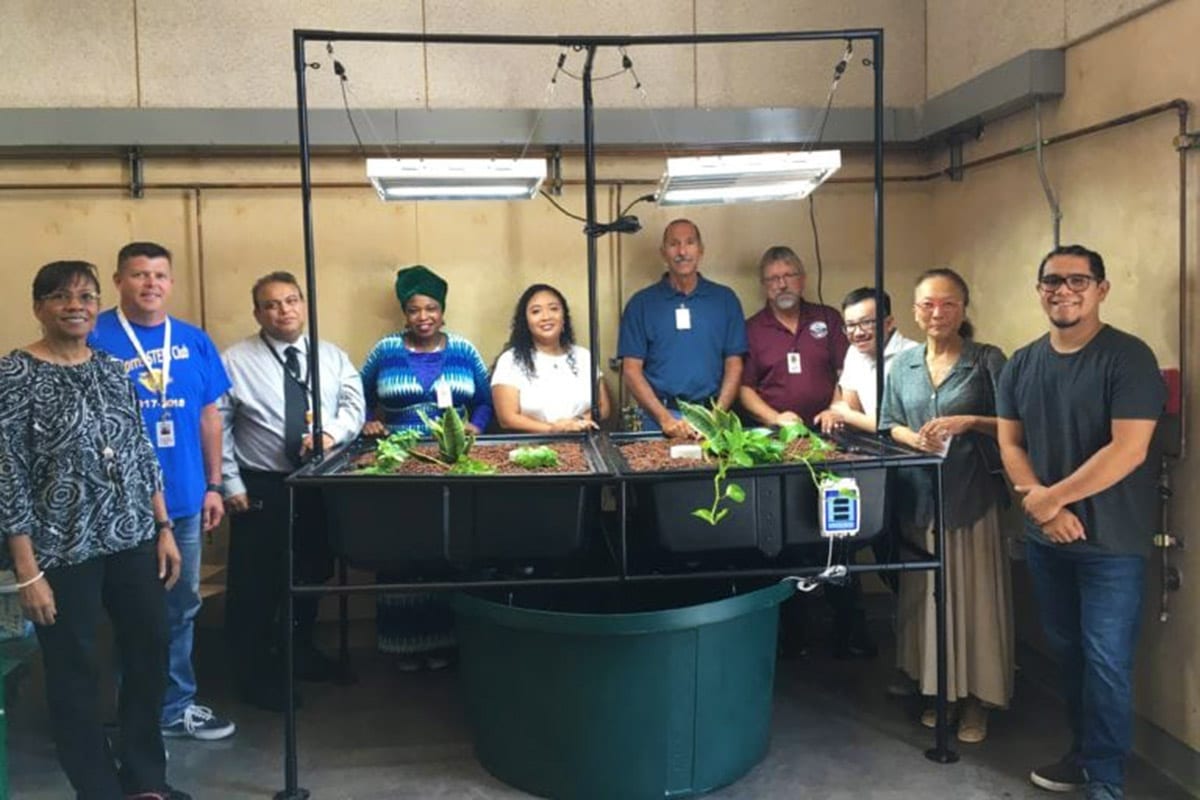
Rialto is, in terms of geography, a chaparral. In a blog for Ten Strands, Ms. Chan opens by saying, “Welcome to Rialto. About 100,000 people call it home, and like much of the Inland Empire it is about an hour from everything: the beach, the mountains, the desert. But when someone says that you are an hour from everywhere, what does that say about where you are? It’s nowhere?”
Rialto is a community heavily impacted by environmental injustice. Once known for its acres of citrus groves (until the 1970s the Inland Empire was known as the Orange Empire), the area was a tourist destination. Growers made fortunes, but immigrant workers from China, Japan, and Mexico saw little of the profits. African American residents, many of whom are descendents of freed slaves who migrated west as far back as the 1850s, have been in the Inland Empire for several generations and tell stories of self-sustaining Black communities which are interwoven into the history of this place. They all lived in the larger context of a hostile racial climate, experiencing discriminatory policies and occasional mob violence.
In the late 1970s rapid suburbanization took over, with residential subdivisions and shipping warehouses replacing orange groves, and real-estate developers renamed the area the Inland Empire. However, one thing has remained constant throughout these changes: whether pollution came from the toxic oily smoke burned to protect the oranges from cold, or from commuters driving to Los Angeles, or the endless caravan of eighteen-wheelers moving freight between warehouses, air and water pollution has always disproportionately impacted the Inland Empire’s communities of color and poor residents more dramatically than their white counterparts. Water has always been, and continues to be, a defining concern regarding issues around both supply and quality.
Partnerships Supporting STEM Education
Ms. Chan realized early on that the local environment was a powerful tool for not only student-centered learning and achievement, but also for building stronger communities.
As a classroom teacher she used California’s EEI Curriculum units, and began training her peers to use them as well. As the Project Director of Rialto’s California Mathematics and Science Partnership grant, she worked to infuse environmental education into all levels of K–12 curriculum, creating sequential science and environment-based learning modules across all grade bands. In the process of designing the units, Ms. Chan sought input from various stakeholders in the community, laying the groundwork for potential partners to support a variety of student learning experiences.
It would be an understatement to say that she is an advocate for science and environmental literacy; she is a champion who cares deeply for her community and students—but the effort to provide every student districtwide with comprehensive, relevant science and environmental learning extends beyond what classroom instruction is equipped to provide.
Science, environment, community. How might a public K–12 district achieve the goals of supporting all students to successful, engaged, and active participants in all three areas? While Ms. Chan has passion, and the support of Assistant Superintendent Dr. Edward D’Souza and Superintendent Dr. Cuauhtémoc Avila, Rialto has over 20 school sites and 27,000+ students. Mastery of Next Generation Science Standards (NGSS), access to STEM learning and career pathways, and achieving environmental literacy districtwide requires collaboration beyond what district leaders can provide alone.
The NGSS provided a starting place for curriculum development. Combined with California’s Environmental Principles & Concepts (EP&Cs), EEI Curriculum units, and coordinated professional learning, a team began preparing teachers to use science standards, the local environment, and real-world learning learning focused on solving local problems to reach science achievement goals. Simultaneously, Dr. D’Souza and Ms. Chan worked with others (like the Facilities department) within the district to apply for grants and shift school sites toward becoming Green Ribbon schools.
Along the way, they lobbied Brian Montez, Grounds Maintenance Supervisor, to join the work. Formerly a skeptic of environmental learning, it was a Green Schools Summit which featured a presentation by Sharon Danks (Green Schoolyards America CEO & Founder) that turned Mr. Montez into an advocate, and he began applying for grants to transform school grounds. Early funding and support from Rialto Water Service and the California Conservation Corps started the preparations for what would become outdoor learning spaces at nearly every elementary school site. He continued to design site plans, with attention to drought-resistant plants and water conservation, and secured additional funding. With the support of the school board, and a nod to Rialto’s history, Mr. Montez began planting citrus groves and gardens across district sites, providing spaces for teachers to take their students outdoors while teaching the district’s custom-built, environment-based science lessons. To-date, over 300 citrus and fruit trees have been planted at over 16 school sites in partnership with Incredible Edibles, Rainbird, and others.
Alongside the NGSS work, Ms. Chan and Dr. D’Souza shepherded STEM education at the district. Working with Michael Nguyen, Math, Science, College & Career Pathways TOSA for the district’s Advancement Via Individual Determination program, they formed the STEM Cares team, and worked to expand and highlight the district’s annual STEM fair. The results speak for themselves: in April, 2018 twenty-five Rialto students representing grades 4–12 placed at the bronze, silver, and gold levels at the 36th Annual San Bernardino, Inyo, and Mono County Science and Engineering Fair. The fair is supported through a partnership with Veolia Water’s Generation STEM Program, which also provides scholarships to students whose STEM or water-related projects are selected as winners.
The city of Rialto and Rialto Water Services use a unique public-private concession model to improve infrastructure services. As part of this model, Veolia was contracted to manage the city’s water and wastewater systems. Veolia employees Chandrasekar Venkatraman, Senior Program Manager, and Andrew Coleman, Field Supervisor, are largely responsible for how the international company’s commitment to the communities they serve is expressed in Rialto. Working with the district to engage students in science learning serves two purposes: it provides them a pathway to actuate responsible corporate partnership, and it helps to nurture a home-grown pool of potential employees to fill the growing number of job openings. As Andrew (another Inland Empire native) shared, these are skilled positions that provide workers with above-average benefits and compensation, and meaningful employment that includes using STEM skills while providing an important service to the entire community.
Another district partnership is with the City of Rialto. Perry Brents, Community Services Department Director, oversees all of Rialto’s parks and recreation programs and facilities—as well as the senior center, fitness and aquatic center, the Rialto Community Center, citywide special events, child development programs, city-wide excursions, and more. Working with Ms. Chan and the district’s STEM Cares team has resulted in a joint-use agreement between the city and the district, and collaboration on a variety of projects that serve Rialto’s students. District priorities around science, environmental learning, and career pathways, and city priorities around community health and jobs are combined in a number of innovative ways. Fishing in the city, an annual Run Around the Rocks event, high school-to-college bridge classes, Earth-to-table events, Rockhounders geology outings, Safe Routes to School—these are a handful of examples where the city and the district are working together to realize common goals around serving students and meeting community needs. In each of these examples science or STEM learning is incorporated, and rooted in the immediate environment.
Another instance of this partnership between the city and the district came about when Fauset Rahman-Davis, Rialto USD’s Head of Nutrition Services, became involved as part of the STEM Cares team. As part of the districtwide initiative to move toward sustainable practices, she rethought how and what the students were eating with a focus on waste reduction and healthy food options. Concerned about how to serve the district’s high number of students who receive meal assistance over the summer months, she and Mr. Brents worked together to address this need. Working with the city’s Healthy Rialto initiative, they created a program that provides Rialto’s students with free lunches at city parks all summer long—with science and environmental learning included via cooking classes, guided activities, and community service projects.
Support from CAELI
California’s Environmental Literacy Initiative (CAELI) works toward realizing the goal of all students accessing local, standards- and environment-based experiences that enhance their learning inside and outside of the classroom. In a state that serves over 6 million K–12 students, how might this be achieved? One strategy is to partner at the district level in places where there is already commitment, prioritization, and valuation of the environment as an integral part of the learning experience. Rialto is an example of such a place where science and environmental literacy has been prioritized, and initial groundwork has been laid. As part of CAELI’s Leading-edge Exemplar project, Rialto is receiving regional support from the State Education and Environment Roundtable and Inside the Outdoors to help deepen and coordinate the work they have begun to address both scale and sustainability.
Inside the Outdoors, administered by the Orange County Department of Education, has been focused on empowering students, teachers, parents, and communities to explore natural areas and expand their knowledge since 1974. Its focus is on building programs aligned with California science and history–social science standards which allow students to experience the standards in real-world settings.
Lori Kiesser, Development Director at Inside the Outdoors, focuses on K–12 science programs. When California’s Blueprint for Environmental Literacy was released in 2015, she immediately saw the alignments with the work that Inside the Outdoors has been doing, and began to identify ways to incorporate it into organizational goals. One such pathway involves including environmental literacy in a district ‘s Local Control Accountability Plan, which both formalizes commitment and ensures the flow of resources necessary to sustain programs at the budget level. Another avenue of support is around deepening teacher professional learning so that teachers have the tools they need to begin designing their own lesson plans integrated with standards and hands-on activities. Additionally, by strengthening the partnerships already in place, and by engaging new partners, Inside the Outdoors and Rialto district leadership aim to create a scaffolding of support for science and environment-based learning that will help realize district goals to-scale in a sustainable way.
Partnerships and support from local government, community and regional support organizations, and the private sector are critical so that district goals are not inherently reliant on a “superstar” or superintendent—human resources that can (and do) shift. Committed educators and community partners in Rialto have successfully done much of the hard work to begin building districtwide environmental literacy. With support to help formalize and coordinate work, successful models for what student-centered education, based on standards and rooted in the local environment, can do are currently being built.
